
Jonathan Davies
12 mins read
Most of us spend a lot of our time at work asking and answering questions.
And, while most good managers are happy to help their teams out, hearing the same questions over and over again can be frustrating.
Constantly answering questions is distracting, disruptive, and takes away from the time you have to do your work. Plus, it’s no picnic for the employees doing the asking either — particularly if the person they need isn’t available right away.
With a knowledge-sharing platform, you can put a stop to these repetitive FAQs and give employees access to the information they need, when they need it.
What is a knowledge-sharing platform?
A knowledge-sharing platform is a centralized repository where employees can share, organize, access, and store information. Knowledge-sharing platforms give employees easy access to important information and documents such as onboarding checklists, employee handbooks, project documentation, and company policies.
The best knowledge-sharing solutions come with features that make it easy for employees to find and access the information they need. This makes it easier for everyone to get their work done without wasting time hunting through old documents or email threads for information.
Knowledge-sharing platform vs. knowledge base
While a knowledge base and a knowledge-sharing platform perform a similar function, there are some important differences between the two tools. A knowledge base is simply a technology used to facilitate knowledge sharing. This might be as simple as a shared Google Drive that everyone can access.
A knowledge-sharing platform, however, takes this same information and presents it in a more user-friendly and intuitive way. These platforms include tools that make it easier to search for and engage with content. With a well-featured knowledge-sharing platform, employees will be able to see files in their original context, leave feedback and questions for colleagues, and even collaborate on document edits, all within the same application.
Things to consider when choosing a knowledge management platform
If you’re thinking of implementing a knowledge-sharing platform for your organization, you need to make sure it has features you need to make it a useful tool that will slot neatly into your existing workflows.
Here are some things to consider when choosing a solution:
Supported file types
Some organizations run on spreadsheets. Others rely heavily on video content for their internal comms. Whatever the particular needs of your company, you need to ensure you choose a knowledge-sharing platform that can handle the file types you use most often.
Content organization
If your content isn’t organized according to a logical structure, your knowledge-sharing platform could end up creating even more work for your employees. The best solutions come with features like personalized feeds and pages, so that everyone has easy access to the info that’s most relevant to them.
Knowledge access
For your knowledge-sharing platform to be a useful tool, your teams need to be able to easily find the information they need. Look for solutions with intuitive, powerful search functions — some tools will even let you search across other platforms (like your email, Google Drive, and SharePoint) at the same time. A fully searchable people directory is also a useful feature since it helps employees to find the best person to approach with their questions.
Collaborative capabilities
These days, employees need to be able to effectively work together from a distance. To avoid overloading your team with multiple apps and platforms, it’s worth considering tools that combine knowledge-sharing with collaboration.
Bottom-up communication
Knowledge-sharing isn’t a one-way street. Organizations that care about their employees and want them to feel listened to at work should encourage bottom-up communications — which means looking for a knowledge-sharing platform that anyone can contribute to.
Analytics and reporting
Without Advanced Analytics that tell you what content people are accessing, you have no way of knowing which information is really important to your employees. Some solutions (like Happeo) will even give you insights into the searches people are making that don't turn up any results — so you can answer your employees’ questions before they’ve even asked them.
Scale and pricing
Some solutions are really only suited to smaller teams without a huge amount of knowledge to share, organize, and distribute. So, if you’re an ambitious company, make sure you choose a tool that will grow as you do. Different tools also come in at different price points, which is another important factor to consider.
Integrations
Your employees probably already use a bunch of different apps, tools, and programs to do their work each day, and any new tool you introduce needs to work alongside these. Look for tools with integrations with other popular workplace tools like Google Workspace, Microsoft 365, and Slack, for example.
8 best knowledge-sharing platforms to consider
Choosing a knowledge management solution isn’t easy. There are a ton of options out there, which all come with their own unique feature sets and use cases. To make things easier, we’ve broken down eight of the top knowledge-sharing platforms for 2022 below.
Happeo
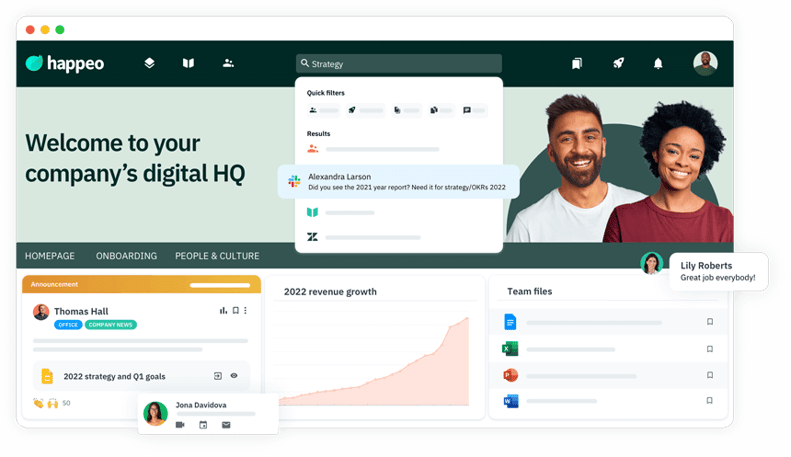
Happeo is a knowledge-sharing platform, employee intranet, and social environment conveniently rolled up in one user-friendly application. You can use Channels to share content and collaborate with colleagues, and create dynamic intranet Pages to store your company’s most important information.
Happeo’s powerful Universal Search function lets you search across your emails, Google Drive, intranet pages, and more all at once, so you don’t need to waste time looking for the right file. And with our Federated Search add-on, you can search across third-party apps at the same time too.
Auto-generated, fully-searchable employee profiles mean that the subject matter expert you need is never more than a few clicks away. Plus, thanks to Happeo’s range of useful integrations, you can even check their calendar, ping them a quick message, or hop on a video call, all from within Happeo.
Key knowledge-sharing features:
- Personalized feeds and home pages to avoid information overload
- Channels to facilitate communication and collaboration
- Universal search function (and federated search add-on)
- Fully searchable employee directory and org chart
- Advanced Analytics to tell you what content is the most valuable
- Deep integrations with Google Workspace, Office 365 and more

“We needed a solution like Happeo because in our fast growing business, information was easily getting misplaced and our employees were loosing time trying to find what they needed to get their job done. We chose Happeo because of its great user reviews, user friendliness and deep integrations with Jira, Sharepoint and OneDrive."
Joakim Rosdahl
Sysarb’s CPO
Google Workspace
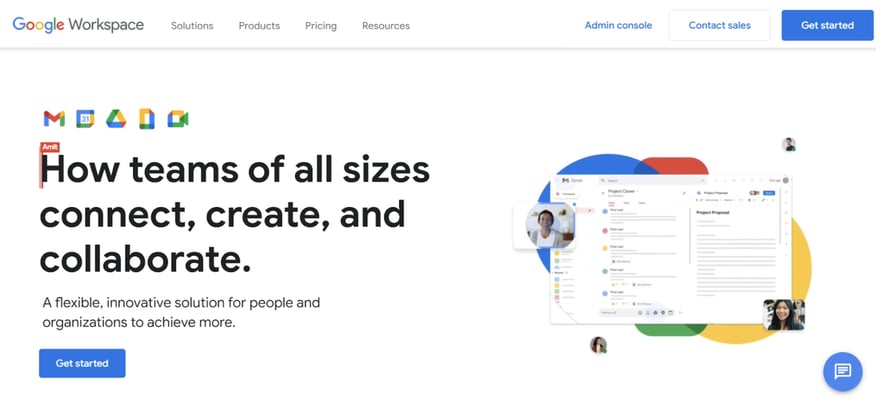 Google Workspace is a suite of workplace collaboration tools designed to make work easier, including Gmail, Drive, Docs, Meet, and more. Google Drive is a file storage application that can function as a company knowledge base, allowing you to store and organize all of your company’s documents and information in a way that’s logical and easy to access.
Google Workspace is a suite of workplace collaboration tools designed to make work easier, including Gmail, Drive, Docs, Meet, and more. Google Drive is a file storage application that can function as a company knowledge base, allowing you to store and organize all of your company’s documents and information in a way that’s logical and easy to access.
And, when you combine this functionality with collaboration and communication tools like Gmail, Meet, and Chat, the whole thing functions as a powerful knowledge-sharing platform. Google’s tools are all interconnected, creating a smooth and seamless workplace collaboration experience.
Key knowledge-sharing features:
- Comprehensive collaboration tools
- Powerful search function
- Flexible tools and features: use the tools you need
- Document management through Google Drive
- Interconnected tools for communication, collaboration, and knowledge-sharing
Microsoft SharePoint
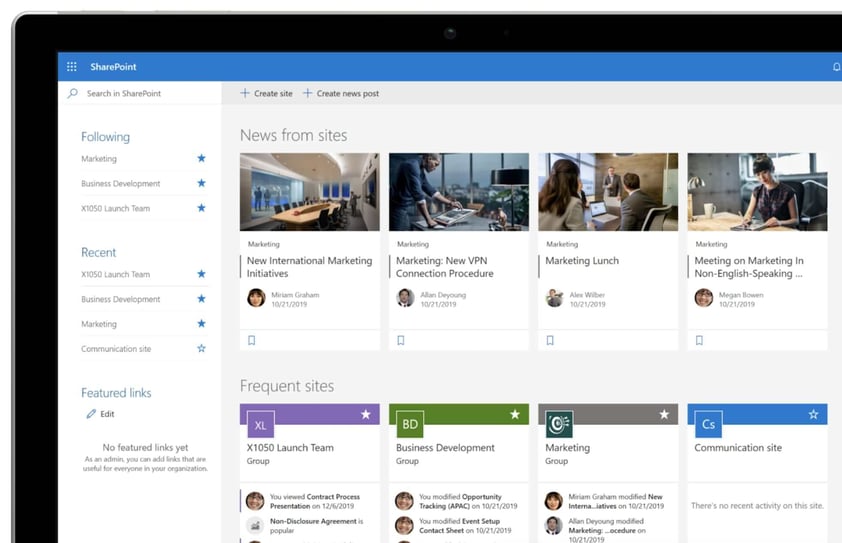
Microsoft SharePoint is a knowledge-sharing and collaboration platform built around a traditional intranet structure. Users can create professional-looking internal or external-facing sites containing a company’s important knowledge. Since it’s a Microsoft product, SharePoint integrates well with other Microsoft tools.
One of SharePoint’s biggest selling points is that it’s extremely customizable depending on the needs of your organization. However, this flexibility does mean it’s complicated to configure, and you may need a dedicated SharePoint administrator to maintain it.
Key knowledge-sharing features:
- Code-free intranet page building
- News and announcement feeds
- AI-powered content suggestions
- Security features: encryption and access control
- Strong integrations with other Microsoft programs
Confluence
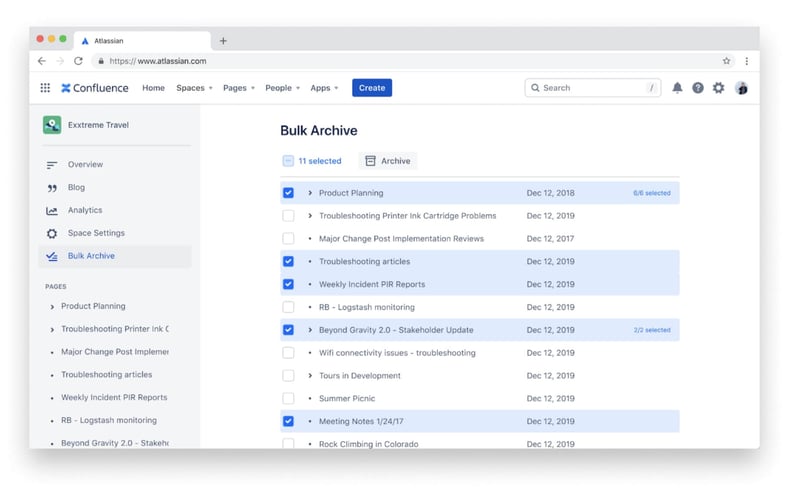
Confluence is an intranet and knowledge management platform owned by Australian software company Atlassian. Teams can use it to share, store, organize and collaborate on various types of content. The platform’s powerful search function and page tree view mean it’s easy to find the right file.
Confluence is an enterprise-level solution that comes with a wide range of features, making it a great tool for large teams. Because of this, it does come with a bit of a learning curve and might seem a bit overengineered for smaller companies.
Key knowledge-sharing features:
- Page tree views and content hierarchy
- Comprehensive search feature
- Custom home pages
- Tags, comments, and task assignments
- Multiple useful integrations
Notion
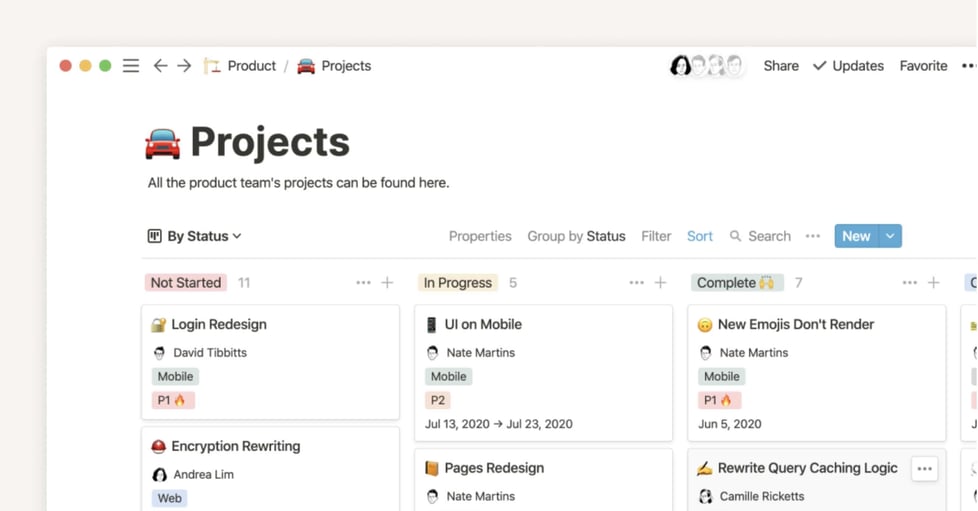
Notion is primarily a project management platform designed to make collaboration easier. However, it also comes with several features that make it useful as a knowledge base and knowledge-sharing solution.
Users can create pages, databases, lists, tables, and more, and draw connections between them so that their colleagues can understand everything in its intended context. It also comes with comment and Q&A features, helping employees to collaborate effectively. Permissions can be set on a page-by-page basis, so you can use Notion as an external knowledge base as well as an internal one.
Key knowledge-sharing features:
- Multimedia embedding
- Code-free page customization
- Easy linking between pages and documents
- Page-by-page permissions
- Comments and questions
Nuclino
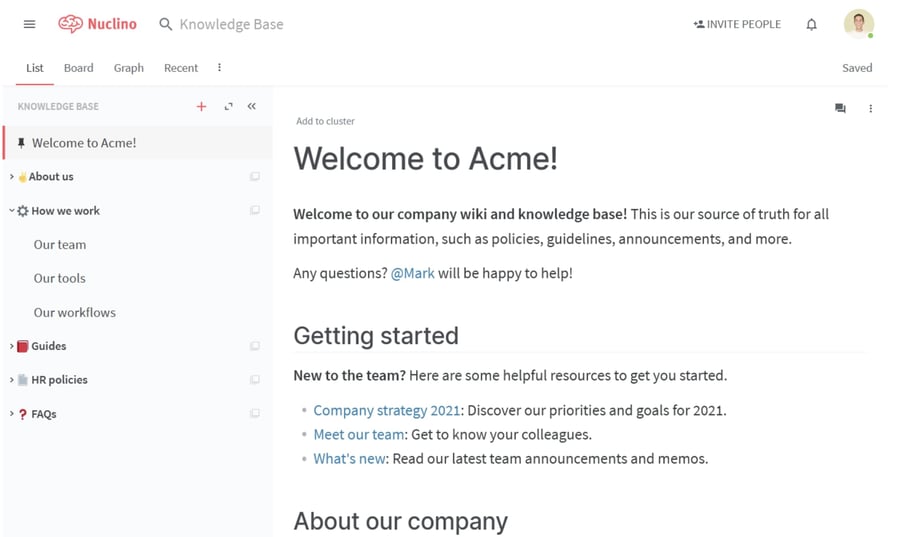
Nuclino is a lightweight and user-friendly knowledge-sharing platform offering a clean and intuitive interface. Teams can use it to create wiki pages including text, images, and videos, using a simple visual editor. You can choose to view data as lists, boards, or graphs to ensure you understand how everything fits together.
Real-time collaboration means colleagues can easily make changes to documents without creating multiple versions, and the platform also comes with a reliable search function that makes finding the right page a breeze.
Key knowledge-sharing features:
- Real-time collaboration
- Fast and reliable search
- Permissions and access rights
- Contextual organization
- 40+ workplace integrations
Papyrs
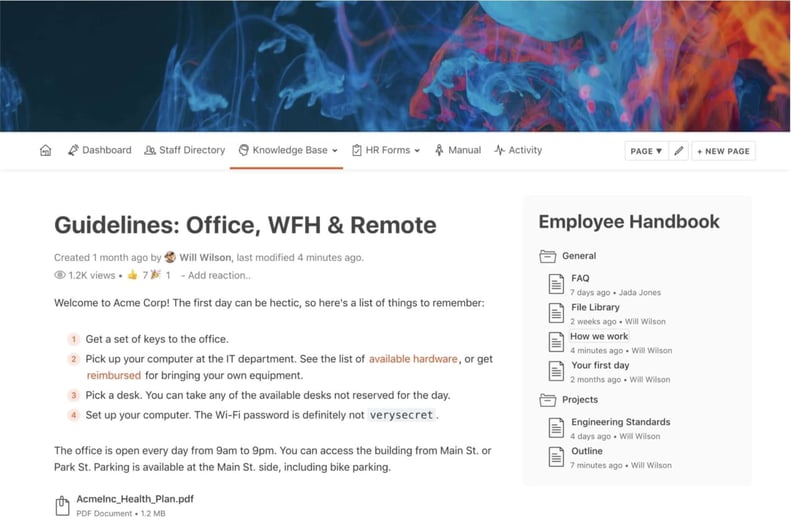
Papyrs is a combined intranet, internal wiki, and knowledge-sharing platform that allows teams to share content and collaborate with each other from anywhere. The platform is based around intranet/wiki pages, which you can create using a simple drag-and-drop editor.
You can embed widgets like polls, checklists, calendars, and forms into your pages, and even drop in files like PDFs, images, and docs so that employees can download them directly. Papyrs comes with a quick and powerful search function.
Key knowledge-sharing features:
- Drag-and-drop layouts
- Comments and reactions
- Version and activity history
- Widgets for polls, checklists, calendars, and more
- User-friendly interface
Tettra
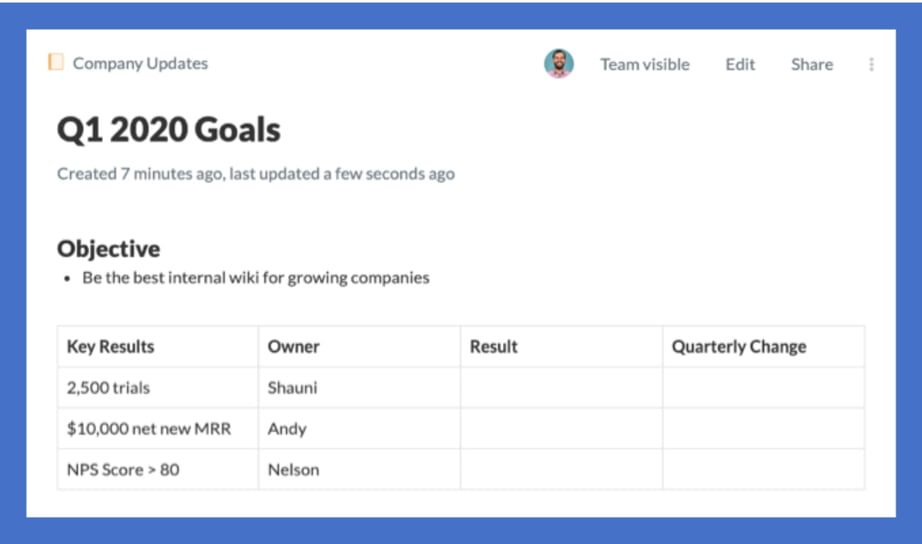
Tettra is a knowledge-sharing platform that lets you store all of your company’s knowledge in one accessible location. Anyone can contribute to the knowledge base using the simple page builder. When there’s a knowledge gap that needs to be filled, you can tag in the relevant person to ask them to add the info that’s needed.
One of Tettra’s most stand-out features is its Slack integration: users can ask questions directly in a Slack channel, which then pulls in the answer from Tettra.
Key knowledge-sharing features:
- 30-day version history
- Slack Q&A
- Easy-to-use interface
- Verification by subject matter experts
- Integrations with MS Teams, Google Workspace, GitHub, and more
Choosing the right knowledge-sharing platform for your organization
The right knowledge-sharing platform will look different for every organization, as the best choice depends on your exact needs and workflows. All of the platforms mentioned above come with their own unique features, benefits, and downsides, and the perfect solution for one company won’t necessarily work for another one.
Happeo is a highly rated knowledge management solution with social intranet and collaboration features included. Users rate its ability to democratize knowledge in an organization, helping top companies to break down information silos and increase productivity.
If you’d like to find out more about how Happeo could help your organization, you can book a free demo call to learn more.


